Also on this page: Habitat
| Water | Trees | Shrubs and PerrenialsOur Wildlife Gardens
We like to make our gardens and woods as wildlife friendly as we can. We operate a no spray policy on all gardens and instead use the "right plant right place" approach to gardening. We plant slug resistant and drought tolerant plants and a range of flowering shrubs and perennials for year round colour and for picking for vases. You may be interested to read our round the year observations in our Nature Blog.
Habitat
Log piles and stumperies
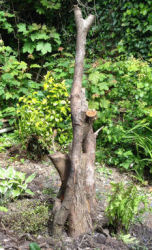 Log piles make a brilliant habitat for all sorts of creatures, from hedgehogs to invertebrates and shelter for small mammals. These are easy to incorporate in the garden.
Log piles make a brilliant habitat for all sorts of creatures, from hedgehogs to invertebrates and shelter for small mammals. These are easy to incorporate in the garden.
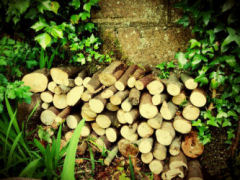 We have several log piles around both of our sites. We introduce new piles most years, so that they are at different times of decay. We also have open compost heaps, some for tops and brush wood, some for leaf mould, some for general weeds. These different heaps also provide shelter and food for wildlife.
We have several log piles around both of our sites. We introduce new piles most years, so that they are at different times of decay. We also have open compost heaps, some for tops and brush wood, some for leaf mould, some for general weeds. These different heaps also provide shelter and food for wildlife.
We also have a number of stumperies, which is a variation on the log pile theme; the base of the stumps are buried and logs of different heights are arranged upright to provide a good house for beetles. There are two stumperies in Hayle, and two huge ones as you go into the woods. Look closely and you will discover they are a hive of activity.

Habitat boxes and hotels
Habitat boxes include bird boxes, bat boxes, hedgehog houses and bug hotels, all of which feature in our gardens and are well used. Bug hotels are great fun to make and can use anything you have lying around; old pallets, bits of brick. We’ve also invested in some woodcrete bird boxes, that keeps eggs and chicks safe from predators.
We also make our own bird and bat boxes out of scrap wood. For some you can try at home, The Wildlife Trusts offer an excellent actions site with lots of practical projects, including how to build a bat box and how to build a bird box.
Top Tip - a piece of wood with holes drilled into it will make a great home for solitary bees and other flying insects.
Brown Roof
We love brown roofs, so much so that we have got them all over the place; on the bike sheds in St Germans and Hayle, on the boiler houses, our summer house, electric box shelter and workshop roof. We make our brown roofs with substrate, crocs and poor soil. This provides a habitat for burrowing beetles, bees and spiders. We’ve planted a few sedums and drought resistant alpines here and there, but the roofs naturally self-seed and vegetation grows and dies according to the weather, thus needing no watering.
Mini Meadows
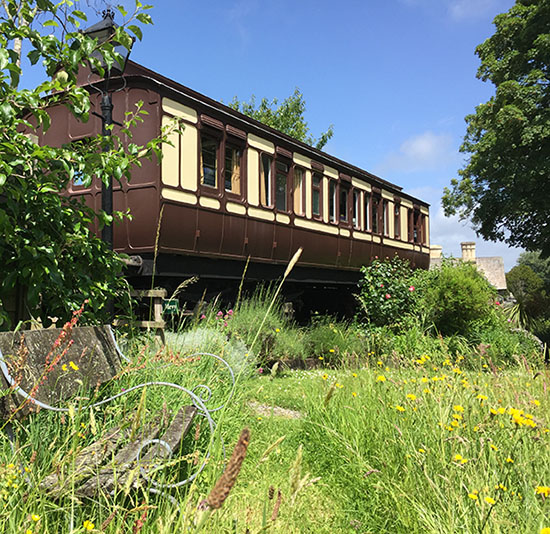 We've left long grass areas in each of our carriage gardens. To these we have added pollen rich flowers; scabious, field poppies, yarrow, dog daisies and spring bulbs, plus some yellow rattle to reduce the vigour of the grass.
We've left long grass areas in each of our carriage gardens. To these we have added pollen rich flowers; scabious, field poppies, yarrow, dog daisies and spring bulbs, plus some yellow rattle to reduce the vigour of the grass.
These meadow areas are trimmed at the end of the summer until late October. They are underplanted with spring bulbs, including crocuses, snowdrops and anemones.
We have also made a meadow clearing in our woods, with a picnic bench, for relaxed wildlife watching. Bring binoculars to enjoy the birds too.
Top Tip - long grass allows small mammals to hide, and makes a good hunting ground for larger predators such as owls.
Water
In St Germans we have two wildlife ponds. Harvey also has a large pond, planted with water lilies, irises and water buttercup from our family ponds at Pommania. It is a joy to watch the birds bathing and see the water boatman whisking across the surface.
Top Tip; Even a little pond the size of a dustbin lid has good wildlife value.
Trees
We have a good range of both fruit and other trees in our gardens. In St Germans we have over twenty fruit trees, including apples, pears, fig, medlar, plums and cherry. We also have numerous cobnuts and two almond and two walnut trees.
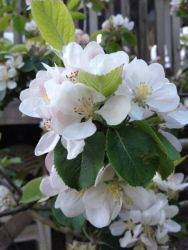 We also have over a dozen fruit trees at Hayle, which we hope our guests pick and enjoy in the late summer and autumn. In addition we have oak (excellent for invertebrates and moths), willow, ash, sycamore, sorbus and spindle in our gardens. There is a variety of mixed broadleaf and conifers in our ten acres of woodland.
We also have over a dozen fruit trees at Hayle, which we hope our guests pick and enjoy in the late summer and autumn. In addition we have oak (excellent for invertebrates and moths), willow, ash, sycamore, sorbus and spindle in our gardens. There is a variety of mixed broadleaf and conifers in our ten acres of woodland.
Several of our trees and hedging plants have been kindly funded by our guests as part of our carbon offsetting scheme. These trees are bought in addition to any other planting, thus funding planting that could not otherwise have taken place. Through our tree planting scheme we have given grants to plant orchards at St Germans Recreation Ground, Moor Barton Rewilding Project and Loveland Community Growers in Penryn.
For more details please visit our Tree Page.
Hedges and fences
Each site has wildlife hedges. So far we have planted well over 1000 hedging whips in the woods, gardens and orchards. These are a wildlife mix of field maple, hawthorn, blackthorn, bird cherry, guelder rose, wild rose, dogwood and hazel.

Copses
Each of our sites has a hazel copse, which creates a gentle shaded hideaway, providing nuts for small mammals through the winter. The planting of the copses was inspired by the many hours Lizzy spent playing in hedges on the farm when a young child.
Top Tip - growing trees, shrubs and perennials of different sizes in your garden is very beneficial to wildlife.
Shrubs and Perennials
We have particularly focused on pollinator friendly planting, and have shrubs and perennials for year round flowers; great for wildlife and flower arranging alike.
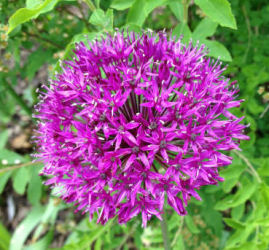 Positive Pollinator planting - butterflies, moths and bees are a fundamental part of our garden interest. We include plants that are especially beneficial; willows, oak, buddleja, lavenders and more. A great measure for how bee friendly your garden is, with tips for increasing the attractiveness to bees, is Beekind Plant Finder. We are proud to say that our gardens in St Germans score 6,594 and in Hayle 4,287, which we plan to build on in the next few years.
Positive Pollinator planting - butterflies, moths and bees are a fundamental part of our garden interest. We include plants that are especially beneficial; willows, oak, buddleja, lavenders and more. A great measure for how bee friendly your garden is, with tips for increasing the attractiveness to bees, is Beekind Plant Finder. We are proud to say that our gardens in St Germans score 6,594 and in Hayle 4,287, which we plan to build on in the next few years.
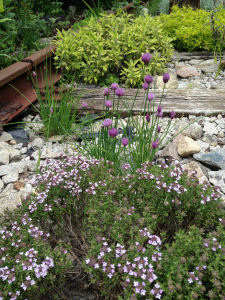 Herb Gardens - on each site we have a large herb garden, which is great for cooking with, as well as providing excellent drought resistant pollinator friendly borders. In St Germans our herbs include chives, thyme, fennel, rosemary, oregano, marjoram, winter savoury, hyssop, sorrel (it may look like a dock, but it’s not!) artichoke, sages, parsley, curry plant, angelica and lavenders.
Herb Gardens - on each site we have a large herb garden, which is great for cooking with, as well as providing excellent drought resistant pollinator friendly borders. In St Germans our herbs include chives, thyme, fennel, rosemary, oregano, marjoram, winter savoury, hyssop, sorrel (it may look like a dock, but it’s not!) artichoke, sages, parsley, curry plant, angelica and lavenders.
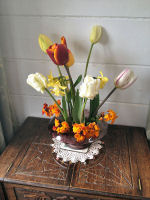 Year round flowers - in St Germans we've tended to group our different beds so each is spectacular at a different time. The following plants are particularly good in each season:
Year round flowers - in St Germans we've tended to group our different beds so each is spectacular at a different time. The following plants are particularly good in each season:
- Winter - hellebore, dwarf comfrey, viburnum tinus, viburnum bodnatense Dawn, winter flowering camellia, winter jasmine, spotty clematis, crocus, anemone, snowdrops, dwarf hyacinths, ornamental quince, rosemary, viburnum tinus.
- Spring - osmanthus, daffodils, tulips, crocus, forget-me-nots, viburnum burkwoodii, camellias, hyacinths, bluebells, wild garlic, wood anemone, scilla, fritillaries, bugle, celandine, Lily of the valley, azaleas, fruit trees, rhododendron.
- Summer - wild flowers including campion, bluebell, buttercup, cow parsley, scabious, poppies, lots of herbs including sage, thyme, fennel, mints, angelica, valerian, hysopp, winter savoury, catmint, roses of all kinds, iris, geraniums, centuary, dicentra, sweet william, phlox, alchemilla, cotoneaster.
- Autumn - asters, sedum, dahlia, mahonia, autumn flowering camellias, Japanese Anemones.
Two great resources for pollinator plantings are produced by the Royal Horticultural Society; Perfect for Pollinators Plant List and Perfect for Pollinators Wildflowers Plant List.
And the best thing of all is that we have beautiful flowers for our vases all year round!
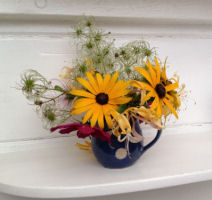
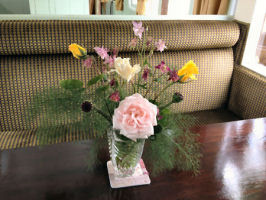
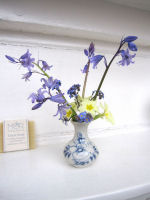
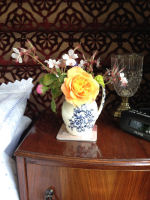
Our Pinterest Wildlife gardening page has lots of ideas for things you could do to create habitat at home. Here is the link to our Pinterest Board.
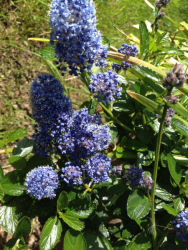
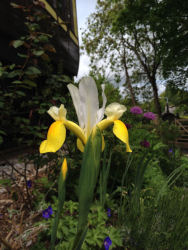
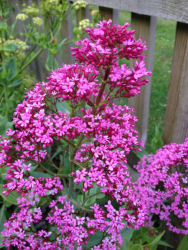
Back to TOP
Contact Railholiday by email at office@railholiday.co.uk or by phone on (+44) 01503 230783. ©



